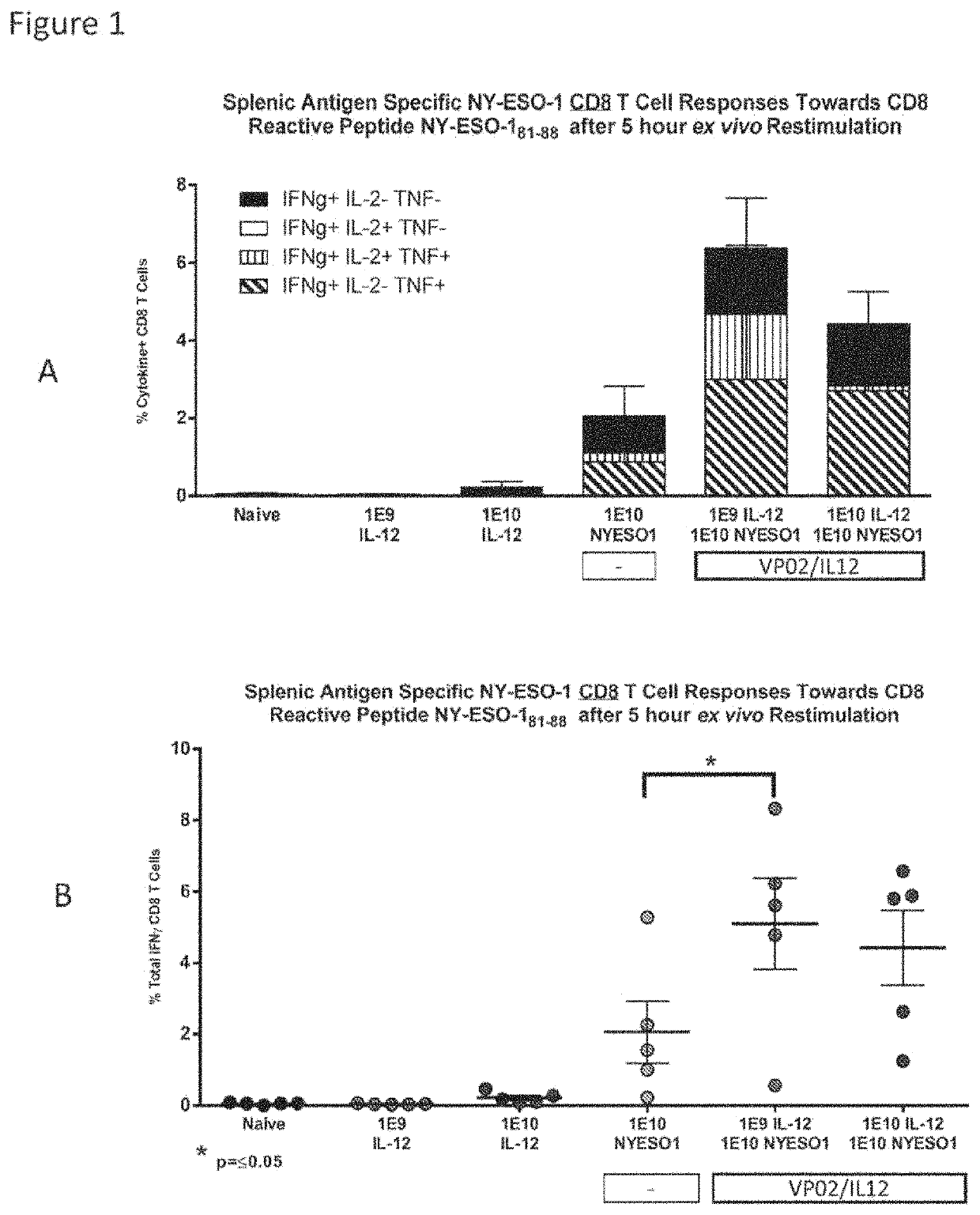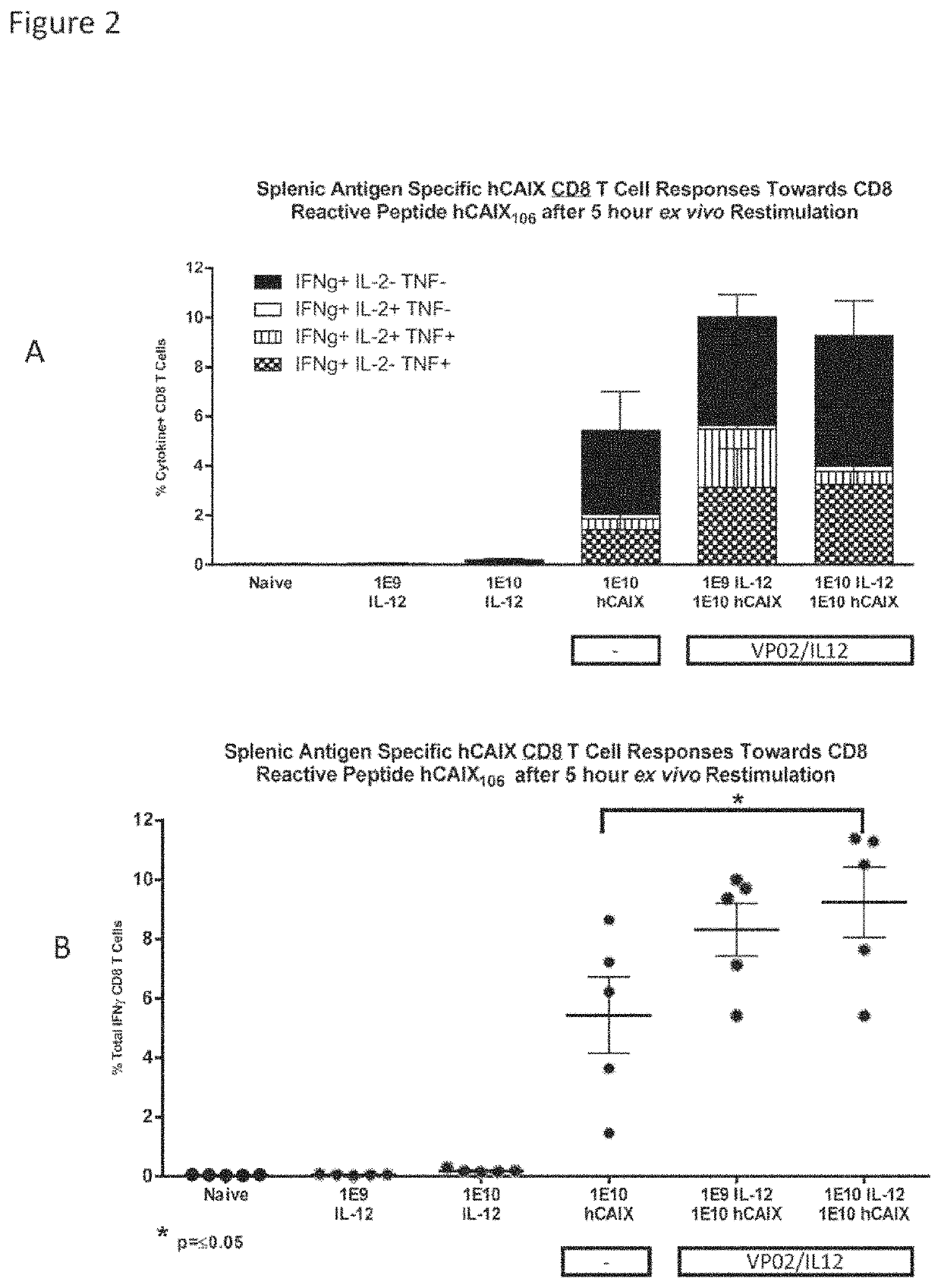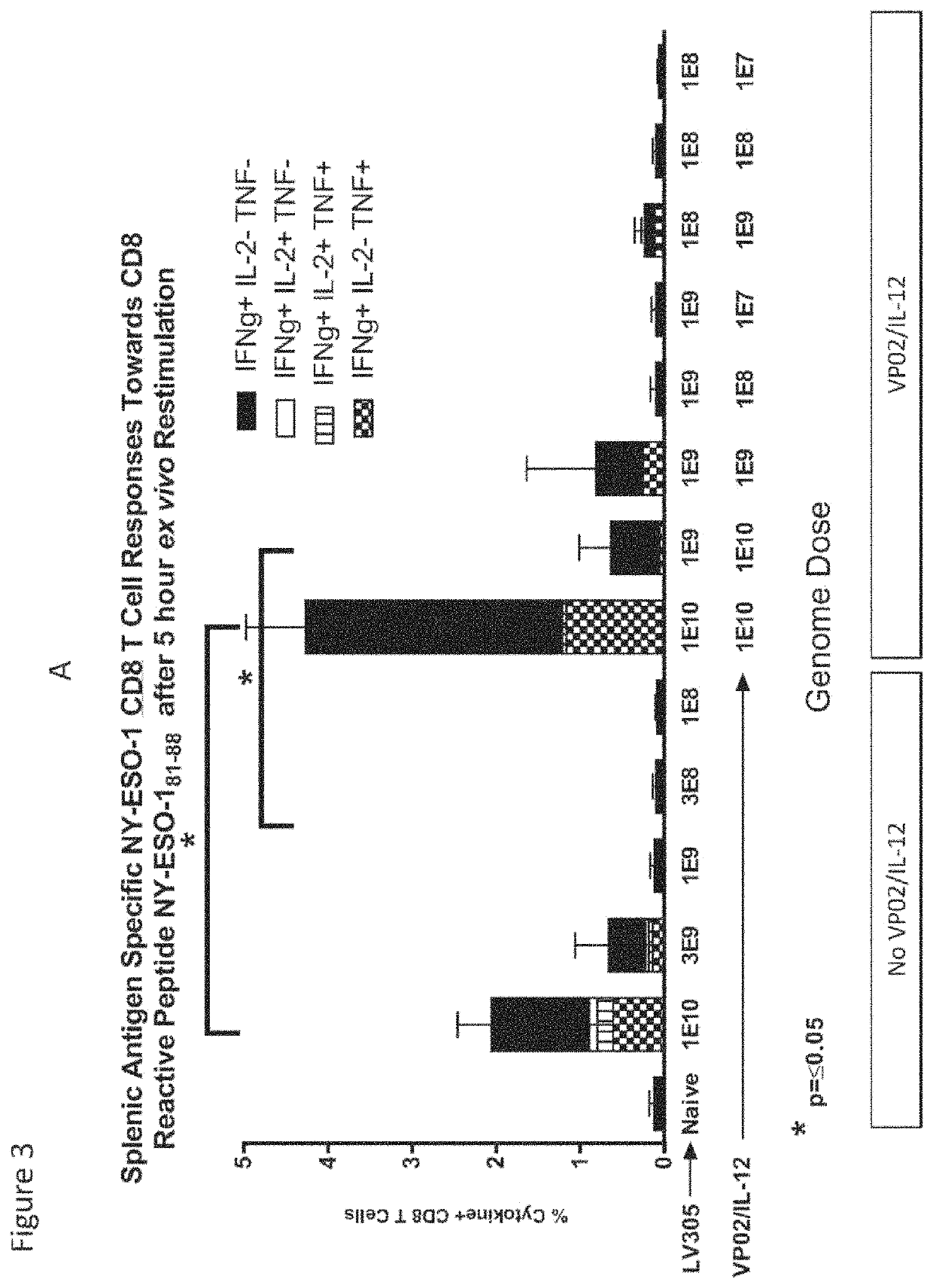Compositions comprising lentiviral vectors expressing IL-12 and methods of use thereof
a technology of lentiviral vectors and compounds, applied in the field of cancer treatment, can solve the problems of inability of the immune system to protect against tumors, general inability to recognize and eliminate tumors, and initial human trials employing this approach were less promising
- Summary
- Abstract
- Description
- Claims
- Application Information
AI Technical Summary
Benefits of technology
Problems solved by technology
Method used
Image
Examples
example 1
Engineering of a Lentiviral Vector Expressing IL-12
[0246]A lentiviral vector pseudotyped with a modified Sindbis E2 envelope glycoprotein that targets the lentiviral vector to dendritic cells expressing DC-SIGN (see e.g. U.S. Pat. Nos. 8,187,872 and 8,323,662) was engineered to express murine IL-12 (referred to herein as VP02 / IL-12). IL-12 is composed of 2 disulfide linked to subunits, p35 and p40. Two different constructs were prepared with both subunits connected via an elastin linker but in different orientations: p35-elastin-p40 and p40-elastin-p35 (p35-L-p40; p40-L-p35). Initial experiments showed that the p40-L-p35 vector produced much higher quantities of IL-12. In a functional bioassay, 293-DC-SIGN cells were transduced with VP02 / IL-12 candidates and culture supernatants were collected. Murine splenocytes were incubated with the supernatants. In a time course experiment from 1 to 48 hours, spleen culture supernatants were collected and analyzed for secreted IFNγ. The results...
example 2
VP02 / IL-12 Co-Delivered with Lentiviral Vector Expressing Tumor Antigen Enhanced Tumor-Antigen-Specific CD8 T Cells
[0261]This experiment shows that co-delivery of VP02 / IL-12 with VP02 expressing a tumor antigen enhances the antitumor antigen CD8 T cell response.
[0262]Two experiments were carried out to evaluate if the presence of IL-12 generated from the VP02 / IL-12 lentiviral vector in combination with the expression of a tumor associated antigen expressed from a VP02 lentiviral vector, can enhance antigen-specific CD8 T cell responses in mice.
[0263]Female C57 / BL / 6 or B6D2 / F1 mice were immunized subcutaneously at the base of the tail with VP02 / IL-12 and VP02 / Tumor antigen (either NY-ESO-1 or CAIX) according to Table 1. Splenic T cell responses were measured 13 days post immunization by intracellular cytokine staining after ex vivo re-stimulation with CD8 reactive peptides.
[0264]
TABLE 1Component[Stock]Final Dose / mouseDose VolumeVP02 / IL-125.9E111.5E9, 1.5E1050 μL (s.c.)VP02 / hCAIX1.4E1...
example 3
Co-Administration of VP02 / IL12 Enhanced the Therapeutic Activity of High Dose of VP02 / hCAIX
[0268]This Example describes experiments conducted to test the therapeutic benefits of VP02 / hCAIX with VP02 / IL-12 on mice that have been challenged with the BC.12 hCAIX expressing tumor clone.
[0269]Mice were injected subcutaneously in their right flank with BC.12 tumor cells expressing hCAIX. Therapy was administered at Day 8. Tumor sizes were recorded every 2-3 days. The basic experimental protocol is shown in Tables 2 and 3 below.
[0270]
TABLE 2Total TestArticleFinal Dose / DoseComponent[Stock]mouseVolumeFull Length hCAIX0.3 mg / mL5, 0.5 μg50 μLVP02 / hCAIX7.1E112.5E1050 μLVP02 / IL-125.9E111E10, 1E650 μL
[0271]
TABLE 3Vector DoseVector DoseGroupn-B6 micehCAIXIL-12110——25—1.0E10 (s.c.)35—1.0E6 (s.c.)4102.5E10 (s.c.)—5105.0E9 (s.c.)—6102.5E10 (s.c.)1.0E10 (s.c.)7105.0E9 (s.c.)1.0E10 (s.c.)
[0272]As shown in FIG. 6, co-administration of VP02 / IL12 enhanced the therapeutic activity of high dose of VP02 / hCAI...
PUM
| Property | Measurement | Unit |
|---|---|---|
| concentration | aaaaa | aaaaa |
| concentration | aaaaa | aaaaa |
| concentration | aaaaa | aaaaa |
Abstract
Description
Claims
Application Information
 Login to View More
Login to View More - R&D
- Intellectual Property
- Life Sciences
- Materials
- Tech Scout
- Unparalleled Data Quality
- Higher Quality Content
- 60% Fewer Hallucinations
Browse by: Latest US Patents, China's latest patents, Technical Efficacy Thesaurus, Application Domain, Technology Topic, Popular Technical Reports.
© 2025 PatSnap. All rights reserved.Legal|Privacy policy|Modern Slavery Act Transparency Statement|Sitemap|About US| Contact US: help@patsnap.com



